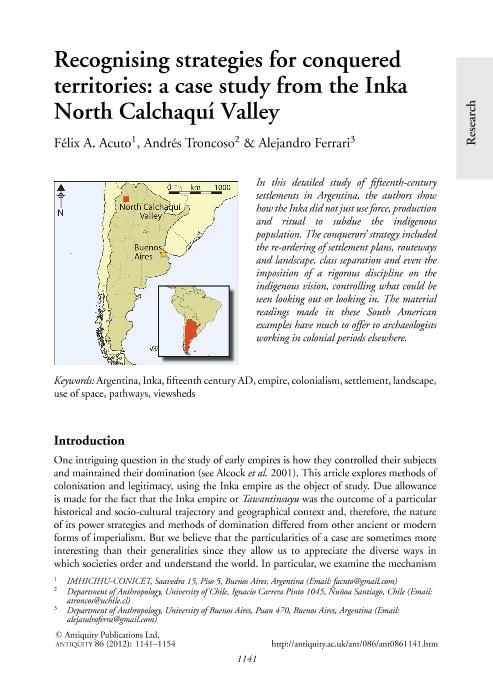Mostrar el registro sencillo del ítem
dc.contributor.author
Ferrari, Alejandro Andrés

dc.contributor.author
Troncoso Melendez, Andres Rolando

dc.contributor.author
Acuto, Felix Alejandro

dc.date.available
2018-04-23T20:02:21Z
dc.date.issued
2012-12
dc.identifier.citation
Ferrari, Alejandro Andrés; Troncoso Melendez, Andres Rolando; Acuto, Felix Alejandro; Recognising strategies for conquered territories: a case study from the Inka North Calchaquí Valley; Cambridge University Press; Antiquity; 86; 334; 12-2012; 1141-1154
dc.identifier.issn
0003-598X
dc.identifier.uri
http://hdl.handle.net/11336/43121
dc.description.abstract
One major concern regarding the study of ancient empires is how they ruled and controlled their subjects and justified their domination (see Alcock et al. 2001). This article explores ancient empires’ strategies of colonization and legitimacy, the Inka Empire’s in this case, taking into account that the Inka Empire or Tawantinsuyu was the outcome of a particular historical and socio-cultural trajectory and geographical context and, therefore, the nature of its power strategies and methods of domination differed from other ancient or modern forms of imperialism. We believe that the particularities of each case are sometimes more interesting than their similarities since they allow us to appreciate the diverse ways in which societies order and understand the world. This paper offers a case study that will contribute to deepen our understanding of the variability of ancient imperialism and that students of past empires can use to compare and contrast with their own cases. Here we examine Inka rule over the North Calchaquí Valley (Figure 1), showing that the strategic use of architecture and the manipulation of people’s corporal experience within Inka places were key aspects of Tawantinsuyu’s domination in the region.
dc.format
application/pdf
dc.language.iso
eng
dc.publisher
Cambridge University Press

dc.rights
info:eu-repo/semantics/openAccess
dc.rights.uri
https://creativecommons.org/licenses/by-nc-sa/2.5/ar/
dc.subject
Imperio Inka
dc.subject
Valle Calchaquí Norte
dc.subject
Estrategias de Dominio
dc.subject
Arquitectura
dc.subject.classification
Historia

dc.subject.classification
Historia y Arqueología

dc.subject.classification
HUMANIDADES

dc.title
Recognising strategies for conquered territories: a case study from the Inka North Calchaquí Valley
dc.type
info:eu-repo/semantics/article
dc.type
info:ar-repo/semantics/artículo
dc.type
info:eu-repo/semantics/publishedVersion
dc.date.updated
2018-04-16T14:46:47Z
dc.identifier.eissn
1745-1744
dc.journal.volume
86
dc.journal.number
334
dc.journal.pagination
1141-1154
dc.journal.pais
Reino Unido

dc.journal.ciudad
Cambridge
dc.description.fil
Fil: Ferrari, Alejandro Andrés. Consejo Nacional de Investigaciones Científicas y Técnicas. Oficina de Coordinación Administrativa Saavedra 15. Instituto Multidisciplinario de Historia y Ciencias Humanas; Argentina
dc.description.fil
Fil: Troncoso Melendez, Andres Rolando. Universidad de Chile; Chile
dc.description.fil
Fil: Acuto, Felix Alejandro. Consejo Nacional de Investigaciones Científicas y Técnicas. Oficina de Coordinación Administrativa Saavedra 15. Instituto Multidisciplinario de Historia y Ciencias Humanas; Argentina
dc.journal.title
Antiquity

dc.relation.alternativeid
info:eu-repo/semantics/altIdentifier/doi/https://doi.org/10.1017/S0003598X00048304
dc.relation.alternativeid
info:eu-repo/semantics/altIdentifier/url/https://www.cambridge.org/core/journals/antiquity/article/recognising-strategies-for-conquered-territories-a-case-study-from-the-inka-north-calchaqui-valley/7B27E47DA12522D6A6128E30061F91DE
Archivos asociados
